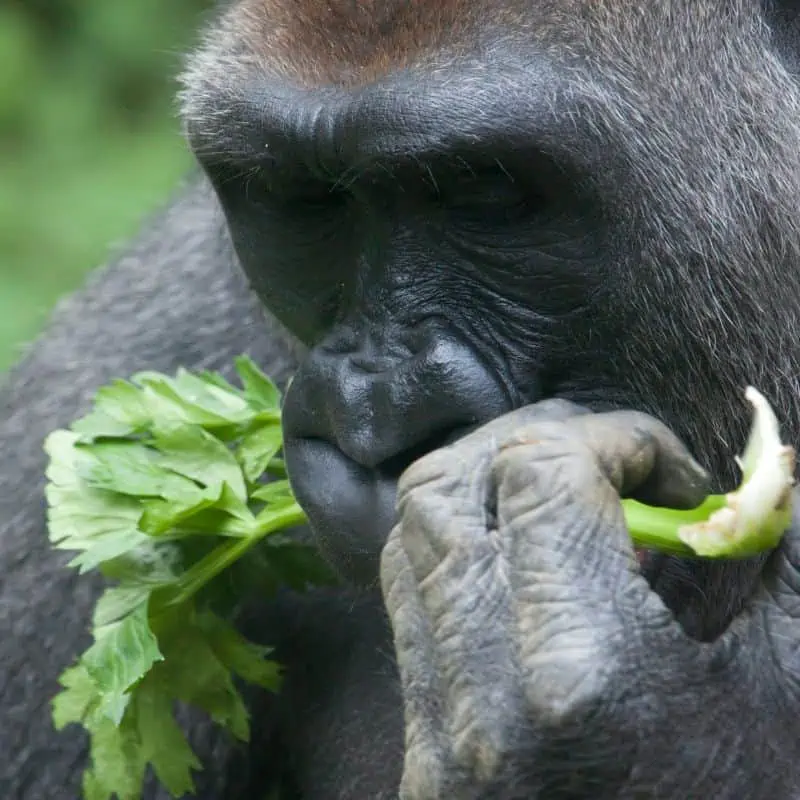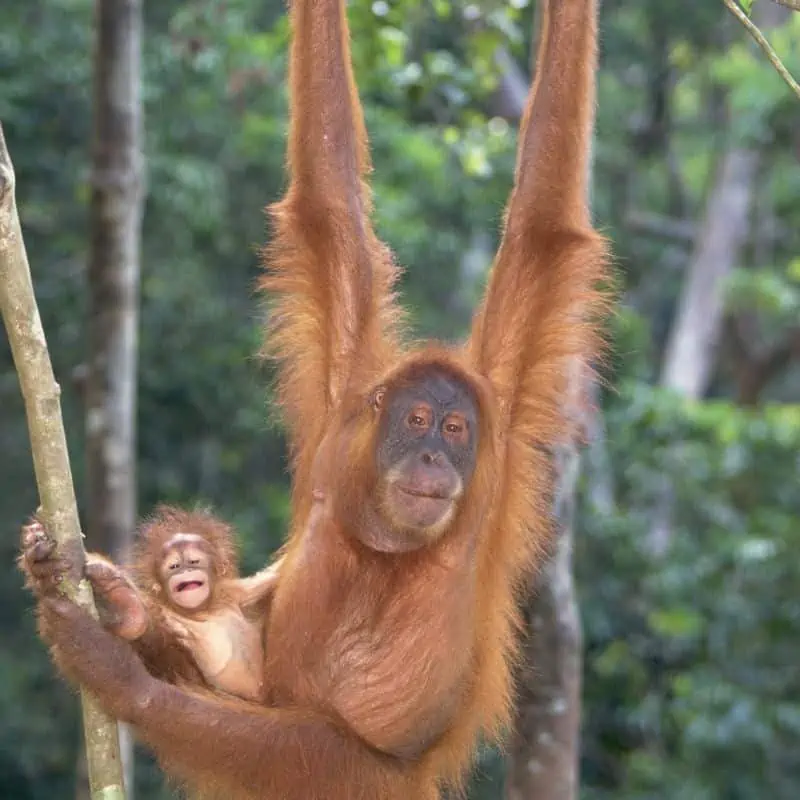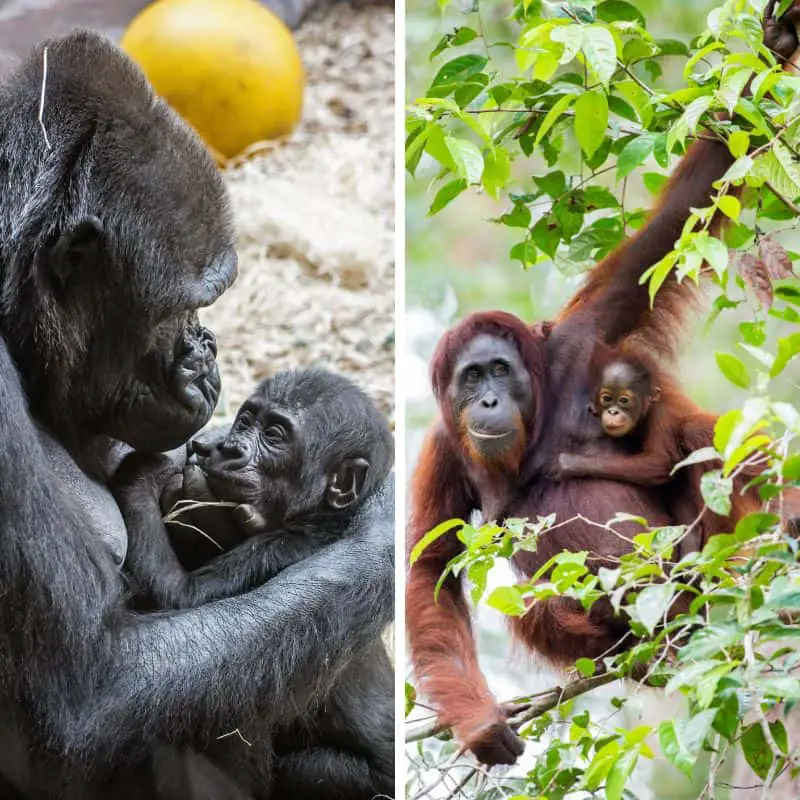Orangutans and gorillas are among the most popular apes in the world. Though they share many characteristics, there are also distinctions between them. So when you encounter either of them, is it easy to tell between an orangutan vs gorilla?
Orangutans are arboreal, critically endangered species of South Asia and differ from gorillas with a smaller size, lesser strength, lesser speed, and longer breeding cycles. Gorillas have a dark black appearance, whereas some orangutans have reddish hair.
This article will look at 12 factors that set gorillas and orangutans apart.

- Orangutan vs Gorilla: 12 Distinguishing Factors
- 1. Orangutans Are Lighter Than Gorillas
- 2. Gorillas Are Slightly Taller Than Orangutans
- 3. Orangutans Prefer Fruit, While Gorillas Are Primarily Vegetarian
- 4. Gorillas Have More Bite Force Than Orangutans
- 5. Gorillas Can Lift More Than Orangutans
- 6. Gorillas Have More Grip Strength Than Orangutans
- 7. Gorillas Are Faster Than Orangutans
- 8. Orangutans Are Solitary, While Gorillas Are Social
- 9. Orangutans vs Gorillas – A Similar Life Span
- 10. Gorillas Have Shorter Breeding Cycles Than Orangutans
- 11. Home On Different Continents
- 12. Conservation Status – Endangered To Critically Endangered
- Final Thoughts On Orangutan vs Gorilla Differences
- FAQs
Orangutan vs Gorilla: 12 Distinguishing Factors
Out of all the animals in the world, orangutans and gorillas are some of the closest to human beings. They share 96.4% and 98.3% of their genes with us.
Although they have a lot in common, some things still make them different from each other.
Here are 12 distinguishing features between orangutans and gorillas:
1. Orangutans Are Lighter Than Gorillas
Orangutans and gorillas are both hefty in terms of their body weights.
Orangutans weigh more than 200 pounds, while females have lower body weights and makeup up one-third to half of the male body weight.
The weight of gorillas varies across species and sub-species, but it is greater than that of orangutans. Here’s an overview:
- Mountain Gorilla: 300-485 pounds, the heaviest ever recorded is 589 pounds
- Western Lowland Gorilla: 150-400 pounds
- Eastern Lowland Gorilla: up to 440
- Cross River Gorilla: males can weigh up to 440 pounds while females weigh half of that (220 pounds)
2. Gorillas Are Slightly Taller Than Orangutans
Orangutans are incredibly large creatures. For example, a male orangutan has an average arm span of 7 feet from fingertip to fingertip.
When standing upright, their hands can reach the ground. When we talk about the height of the orangutans, males and females differ a lot in height like:
- Male Orangutans measure between 4.1 – 5 feet tall
- Female Orangutans have an average height of 3.3 feet, almost half the size of males.
Gorillas, however, have varying heights among subspecies, although they all fall within a similar height range.
Gorillas and orangutans share a comparable height. Here’s an overview of the different gorilla subspecies:
- Mountain gorillas have a height of 4-6 feet when standing on two feet
- Western lowland gorillas stand 4-5.5 feet tall when standing on two feet
- Eastern lowland gorillas have a height of 4-5.5 feet standing upright
- Cross river gorillas also have almost the same height as the rest of the subspecies, 4-5.5 feet
3. Orangutans Prefer Fruit, While Gorillas Are Primarily Vegetarian
Orangutans are mainly fruitarians, eating around 300 different kinds of fruit. But they’re technically omnivores; on rare occasions, they consume insects, larvae, or even meat.
Orangutans feed on fruit, with fruit-bearing trees being a preferred food source.
Mother orangutans instruct the infants on what to eat, where to find it, and how much to consume. Orangutans must thoroughly know the jungle’s geography and fruiting cycles to forecast when certain trees will produce fruit.
Gorillas, on the other hand, are primarily vegetarians, eating bamboo shoots, stems, and fruits. Western lowland gorillas, however, have been observed to break into termite nests and consume larvae.

4. Gorillas Have More Bite Force Than Orangutans
Orangutans have a surprisingly strong bite force for their size. Their bite can generate up to 575 psi, making it one of the strongest in the animal kingdom.
Even though gorillas are gentle beasts, they can bite with even more force, up to 1300 psi when needed.
5. Gorillas Can Lift More Than Orangutans
Both gorillas and orangutans can lift a lot more than their body weight.
Orangutans are incredibly strong and can lift around 500 pounds with ease, which is twice the weight of their own body.
Gorillas, on the other hand, can lift an incredible 1000 pounds.
They have a lot of power; imagine a thousand-pound log whacked at you. But don’t panic; gorillas are tranquil animals unless you try to harm or intimidate them.
6. Gorillas Have More Grip Strength Than Orangutans
Orangutans are known for their impressive grip, which allows them to swing from tree to tree.
They have a grip strength of around 600 psi, which is just enough to hang using one hand. They can even use their hands to pound on trees and make noise, which most humans would not want to do.
Gorillas have an even more impressive grip, allowing them to effortlessly break bamboo sticks with a force 20 times greater than an ordinary human.
Gorillas can shatter your skull with only one blow of their arm by applying a force of between 1300 and 2700 pounds.
The explanation for such colossal power is quite straightforward: gorillas have four times the muscular mass of a competitive strongman.

7. Gorillas Are Faster Than Orangutans
Orangutans inhabit trees and have an arboreal lifestyle. They are, in fact, the world’s largest tree-dwelling primates.
As a result, they do not need to travel as quickly or maneuver from the treetops.
However, if they must move on the ground, they can sprint at 2-3 mph, which is about the same speed as brachiating.
Because gorillas are terrestrial, they have developed a sprint speed of up to 25 mph by knuckle-walking or bipedal motion.
8. Orangutans Are Solitary, While Gorillas Are Social
Orangutans are known to be solitary. When they walk alone, they make loud rumbling noises called “long calls” to ensure they don’t get in each other’s way.
They can only be observed in pairs during mating. The pair will stay with the female for many days to ensure a successful mating, after which they’ll go back to living alone.
On the other hand, Gorillas are highly social creatures that live in groups called “troops” and are led by a dominant, older male. Troops may consist of up to 30 members and contain other young males, females, and offspring.
The alpha silverback is in command of the troop’s activities, including foraging for food, building nests, and moving to a new location.
When confronted by another male, the alpha displays his power by standing up straight, flinging objects around, and beating his chest while roaring and barking loudly.
Despite putting on such a show of strength and aggression, gorillas are gentle unless threatened.
9. Orangutans vs Gorillas – A Similar Life Span
Orangutans typically live for 30-40 years in the wild. In captivity, they can reach up to 60 years, though.
Gorillas in the wild live an average of 35-40 years. Gorillas may live up to 50 years in captivity or even longer.
10. Gorillas Have Shorter Breeding Cycles Than Orangutans
The breeding process of orangutans is lengthy. A female reaches puberty at the age of eight but does not begin producing offspring until she is in her early teens.
Baby orangutans are born every eight years on average, with twining occurring rarely.
According to Robert W Shumaker’s research on orangutan reproductive life histories, wild orangutan females reach sexual maturity at 15.4 years (average 13-18 years).
The birth interval is 9.4 years, implying that a female only gives birth once every nine years.
Orangutans, however, reproduce at a faster pace when captive. The data from the 2566 individuals in a captive environment shows that females start reproducing normally at 7.
The birth interval is less than a year, meaning they have babies much more frequently in captivity.
Female gorillas give birth to a single baby every 4 – 6 years. Though they breed faster than orangutans in the wild, this breeding rate is not enough to keep up with a decreasing population. That’s why gorillas are on the verge of extinction
11. Home On Different Continents
Orangutans reside in the tropical forests of Southeast Asia, more specifically on the islands of Borneo and Sumatra and the Malaysian states of Sarawak and Sabah.
There used to be Orangutans present in southern China too, but sadly, they’re now extinct in that region.
To find Orangutans in Sumatra, you should look in Aceh and North Sumatra provinces.
As for Kalimantan, look towards South Kalimantan province if that’s where your interests lie.
Gorillas primarily reside in tropical rainforests in Central Africa, where they can feast on vegetation.
The western lowland gorilla covers a vast area of central and West Africa, including Cameroon, the Central African Republic, the Democratic Republic of the Congo, Equatorial Guinea, Gabon, Angola, and the Republic of the Congo.
The best way to see wild gorillas in their natural habitat while supporting their plight is by gorilla trekking.
12. Conservation Status – Endangered To Critically Endangered
Because of their habitat loss, orangutans are on the verge of extinction. Palm oil plantations, illegal hunting for meat and fur, and the illegal pet trade have threatened their existence.
- According to the most recent estimate, approximately 104,700 Bornean orangutans are left worldwide. This new number is based on an updated geographic range and classifies them as endangered.
- Sumatran orangutans come up with 13,846 individuals and are critically endangered.
- Tanapuli orangutans are one of the most endangered species of great apes, with no more than 800 individuals left.
Gorillas have suffered habitat destruction due to human violence, deforestation, agriculture, and illegal mining of charcoal.
Now, these animals have been listed as endangered to critically endangered depending upon subspecies:
- Mountain gorillas are about 600 in number on the planet. Previously designated as critically endangered by IUCN, but in 2008 upgraded to endangered due to a rise in numbers.
- Western lowland gorilla is a critically endangered sub-species with an alarming decreasing population trend. In 2013, the world’s total was 361,919 individuals, but it is dropping.
- Cross river gorilla is critically endangered, with a total number of 100-250 individuals left.
- Eastern lowland gorilla is critically endangered. They are extremely rare, and their habitat makes their exact numbers difficult to estimate.

Final Thoughts On Orangutan vs Gorilla Differences
Though orangutans and gorillas appear similar because they are both members of the Hominidae family, there is still a lot that differentiates them. Orangutans have smaller bodies and aren’t as strong as gorillas.
They also consume different food items, and gorillas are much faster than orangutans. This is also true for their mating cycles.
Orangutans are native to Southeast Asia and have been classified as critically endangered. In contrast, gorillas reside in central Africa and are either endangered or critically endangered, depending on their numbers and subspecies.
FAQs
Are Orangutans Related To Gorillas?
Though orangutans, gorillas, and chimpanzees belong to different genera, they are all still related because they are part of the same Hominidae family.
Which Is Smarter, Gorillas Or Orangutans?
Gorillas and orangutans are both known for their cognitive skills and intelligence. Orangutans are more widely recognized for their use of tools, learning capacity, and ability to use language. After humans, they are the smartest of the great apes.
Are Orangutans Violent?
Orangutans are generally non-aggressive toward humans and each other. However, many individuals reintroduced into the wild after being in managed care are aggressive toward humans. Male competition for mates and territory has also been observed between adults.

